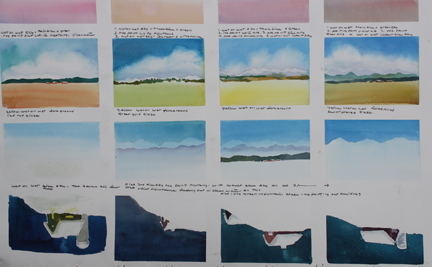
MASS PRODUCING PAINTINGS? This is fun and you may be surprised at how many turn out. Here is a sheet of 12 (plus 4 more that don’t count for this).

MASS PRODUCING PAINTINGS? This is fun and you may be surprised at how many turn out. Here is a sheet of 12 (plus 4 more that don’t count for this).
 Let’s start with the WOW! factor. On occasion, there are paintings, there is music, there are other forms of art that leave you speechless. They are that good. There are paintings that have moved me to tears, as there is music. You know what I mean.
Let’s start with the WOW! factor. On occasion, there are paintings, there is music, there are other forms of art that leave you speechless. They are that good. There are paintings that have moved me to tears, as there is music. You know what I mean.
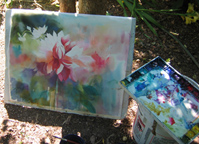 Ruby My Dear in the garden
Ruby My Dear in the garden
Often students ask to have a workshop on finishing paintings. The trouble with this is the way you finish one painting is not the way you finish the next. I can give you some guidelines but when each painting is done is as individual as the painting itself and its creator.
Years ago I was dating a man who had no grasp of what it was to be making art. I gave him the book, “The Zen of Seeing,” and said, “If you are going to understand art, you are going to have to get in touch with your feelings.”
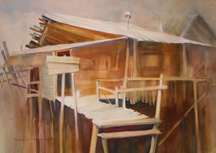 A painting goes off track and I often hear,”How can I fix it.” Sometimes we can. Sometimes, no matter what you do, you have passed a point of no return. It will never be a good painting. People are reluctant to give up because they don’t want to waste all of that time they invested so they keep flailing away, hoping to save the painting. Does this sound familiar?
A painting goes off track and I often hear,”How can I fix it.” Sometimes we can. Sometimes, no matter what you do, you have passed a point of no return. It will never be a good painting. People are reluctant to give up because they don’t want to waste all of that time they invested so they keep flailing away, hoping to save the painting. Does this sound familiar?
What I would like to suggest is, when a painting goes off track, stop and study it. Try to figure out why it is no longer working. Often we can’t tell what it SHOULD look like until we try it once on the paper. Then we see …. this should be larger, that should be eliminated; the colors are wrong; or it is simply overworked. Consider it your first draft.
 Perhaps you have discovered that one of the first things that changes when you start painting and/or drawing is how you see things, how much more you are seeing! This summer while you are spending more time out of doors, PRACTICE SEEING the way a artist looks and sees. An artist does look and see differently. You can learn it faster when you really think about it.
Perhaps you have discovered that one of the first things that changes when you start painting and/or drawing is how you see things, how much more you are seeing! This summer while you are spending more time out of doors, PRACTICE SEEING the way a artist looks and sees. An artist does look and see differently. You can learn it faster when you really think about it.
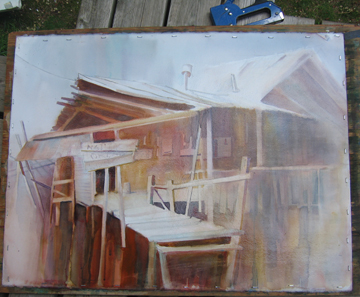
Why stretch your paper?
Watercolor paper expands when it is wet. It shrinks back when it dries. When you wet small areas of the paper you have hills and valleys develop. These are particularly noticeble when you put the painting under a mat. However, if you soak the paper and secure (staples, butcher’s tape) it during its expanded stage, when it tries to shrink, it pulls tight and stays that way.
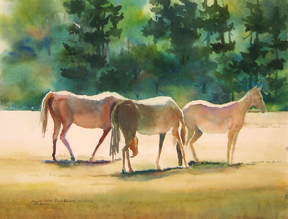 Now that we are headed toward plein air painting, you might find it useful to review the GREEN entry in July and DARKS in August of 08 — which leads us right in to a question that has come up several times this month, “Which colors should I buy?”
Now that we are headed toward plein air painting, you might find it useful to review the GREEN entry in July and DARKS in August of 08 — which leads us right in to a question that has come up several times this month, “Which colors should I buy?”
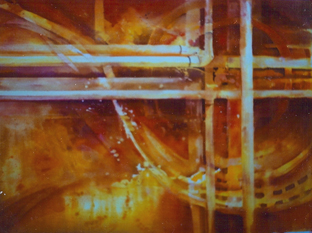 …. And It Comes Out Here, 1992
…. And It Comes Out Here, 1992
Talk about scratching an itch! We have heard from quite a number of people who are excited to be pouring paint (see February technique) and are eager to do more. If you haven’t already read Pouring Paint before now, go back and work you way through the February entry first.
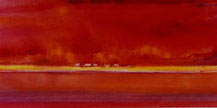 You are going to have some fun.
You are going to have some fun.
You are going to make a mess. You are going to be able to scratch your thrifty itch. And you may find yourself excitedly heading off in new directions.
 My office -studio- guest quarters
My office -studio- guest quarters
This is the time of year to be making resolutions. Perhaps yours is to make a permanent place to paint. Let me share with you some solutions I have learned over the years.
